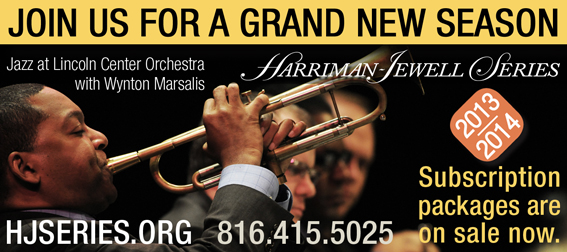IN REVIEW: Ballet closes 2012-2013 season with one of its best programs ever
To be a serious ballet company these days you can’t just do an endless series of Swan Lakes: You’ve got to push things forward. The Kansas City Ballet in its current form has rarely flinched from risky artistic choices, works that might have left us scratching our heads at times. At the season finale that opened May 3rd at the Kauffman Center, the company presented the world premiere of a 25-minute ballet of such startling ingenuity and mind-blowing visuals that it exceeds the boundaries even of what this innovative company has achieved through its 56-year history. Energy Made Visible is a work by Karole Armitage, who grew up partly in Lawrence, that is based on the works and the creative process of 20th-century painter Jackson Pollock, whose abstractions “appear to fuse opposites: lyrical and violent, cathartic and obsessive, ethereal and visceral,” in Karole’s words. Pollock’s “dancing lines of poured paint, thrown standing up as he moved around the edge of the canvas on the floor” have become a jumping-off point for the new ballet, one that I predict history will not forget. I certainly won’t.
The stage design reminded me of the days when top artists of the day worked with Merce Cunningham and others to create visuals so striking they became not just “décor” but fully integrated artworks. (Karole danced in Merce’s company from 1976 to 1981.) The design team here – projection designer Gilles Papain, lighting designer Kirk Bookman, and costume designer Jennifer Carroll – has created a look so beautiful that I literally sucked in my breath when the curtain went up.
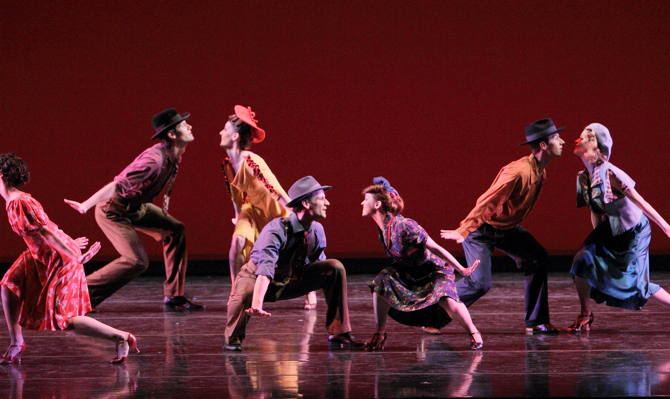 |
Initially you think that the giant screen stretching vertically from the floor, offset slightly toward stage right, is a sort of canvas – until you realize that the real “canvas” is the flooring that stretches downstage beneath the screen, since we know Pollock worked with the canvas on the floor. But the “painting” that is created throughout the ballet appears on the vertical screen – logically, as it is more visible to the audience. Above the stage, giant rectangles of mylar, stretched tightly so as to look like mirrors, are positioned to reflect fragments of the dancing, in ever-shifting refractions. The panels face different directions, so that at times you see an actual reflection of the onstage action, at times a reflection of one of the other panels. Throughout the piece dancers lob “paint” onto the vertical canvas, and it miraculously appears on the screen – in tans and grays and off-whites – courtesy of Gilles’ wizardry. Intermittently, the canvas is wiped clean, only to have the dancers begin to fill it again.
For much of the ballet the dancers are divided into two groups, one on each side of the painting. The group stage right does most of the lobbing, and the larger group stage left dances in all manner of styles ranging from fairly strict classical ballet – at times in unison, at times not – to loose-limbed modern dance suggesting roots, perhaps, in Balanchine, Merce, and others. (Does one see Graham in the totemic, knees-and-arms-squared poses?) But Karole’s choreography has a piquant ferocity all its own: It is as difficult to categorize as the work of any great innovator, and at times as baffling.
The other collaborator in Energy Made Visible is saxophonist Bobby Watson, who steps onstage at the outset and begins playing minimalist introductory licks while Yoshiya Sakurai dances a leaping, lively, completely delightful solo – in which it’s not clear whether Yoshi is accompanying Bobby or vice-versa. Their motions are loosely parallel, and throughout the ballet one is aware of the subtle interactions between musician and dancers. At one point Bobby begins playing over a pre-recorded track of himself, and this process of layering continues until it reaches hellish complexity in the final Mvt. 6.
Bobby is suave and sultry in Mvt. 2 (danced sensuously by Rachel Coats and Jill Marlow) and dizzingly virtuosic in Mvt. 3 (full company, lit with a yellowish glow). At times, as in Mvts. 3 and 6, dancers perform individual movements then suddenly break into unison. Bobby echoes this, playing music that is different from that of his “other self” – then coming together with it. His sound grows lush for Mvt. 5, a sort of double pas de deux of dependence-rejection-reconciliation. Rachel and Anthony Krutzkamp are compelling here, bending and twisting over each other with graceful resistance.
The finale becomes a gigantic geometrical “problem,” with dancers in groups of six stage left and the row of paint-lobbers stage right creating a canvas of ever-increasing complexity – just as the music grows complex to the point of fever-pitch. Bobby is not present at the beginning of the finale, and when he does emerge – playing over the busy multiple tracks of himself – he walks directly into the fray, scattering dancers as he goes. On opening night, technical glitches prevented us from seeing the “finished product” (dancers were lobbing paint but nothing appeared on the screen), so I returned on Saturday and the result was breathtaking. Yet it almost seems that Karole doesn’t want us to dwell too much on the visuals – so the painting is promptly erased and the dancers go into a controlled frenzy.
Jennifer Carroll’s costumes emphasize the same colors as those of the paint being lobbed. Kirk Bookman has done splendid things with lighting design here over the years, but he outdid himself here: This was spectacular. The ever-shifting hues and radiant designs were so subtle you hardly noticed, and so perfectly integrated into the sharp visuals that it was not until afterward that you found yourself thinking about the lighting, as much as about any other element in the design.
Energy Made Visible was a stretch for the Kansas City Ballet – and for its audiences – and I’m certain it was fiendishly difficult to put together (not to mention expensive). But the company can hold its head high knowing it has been a part of creating a ballet that will surely take on a life of its own.
Kansas City audiences know Margo Sappington through works like ZuZu Lounge and Cobras in the Moonlight – fascinating, witty, complex, at times bizarre. Initially a dancer with Joffrey Ballet, Margo is renowned for Oh! Calcutta! and other work on Broadway, in addition to her impressive creativity as choreographer for companies the world over. Common People, created in 2007 for Milwaukee Ballet, is a visual feast from the outset: To the left are tall metallic towers, while shining upward on the drop are light-patterns suggesting the tip of the Chrysler Building (but upside-down). Rows of almost garish lights stretching across the stage change color – red blue, green. The dance is a kinetic blend of comic thrusts and dives, hyper-charged looseness, jazz, ballet, and modern bordering on hip-hop.
Common People is based on excerpts from Has Been, a 2004 album in which William Shatner recites humorous poetry recounting stories from his life, over music by Ben Folds and others. It is a de force of dance, design, music and poetry. The dance is singularly Margo, with elements of Robbins and Broadway, mingling with joyously malleable movement and a bit of show-biz. Meanwhile Shatner’s unmistakable voice punctuates the action, sounding animated (think Priceline) for the punchy, comic stories, low and husky for the romantic and sexy ones. “It Hasn’t Happened Yet” highlights the versatility of Logan Pachciarz (or on alternate nights, Charles Martin), a loose and expressive dance of yearning. On opening night Aisling Hill-Connor and Anthony Krutzkamp were splendid in “Familiar Love,” a duet of serenity in which Shatner expresses his gratitude for familiarity, not daily thrills, with his partner. My only concern was that one couldn’t always hear Shatner’s voice, but maybe that’s okay.
In the ambitious quartet “Ideal Woman,” three men (Michael Davis, Travis Guerin, Geoffrey Kropp) compete for the attention of a demure but tough woman (Laura Wolfe). Laura is dressed in the color of bubble-gum, perhaps a nod to Shatner’s mention of chewing-gum in the narration. In “I Can’t Get Behind That” we hear the voice of Henry Rollins (of all people), and a full ensemble again integrates ballet with other styles. The finale “Has Been” has the ensemble strutting and running, riding each other like bucking broncos, and creating a surprising sense of order out of what appears to be chaos.
Commissioned by Kansas City Ballet and performed here and in New York on the company’s Joyce Theater debut in 2008, Donald McKayle’s Hey-Hay, Going to Kansas City is a marvelous tribute to the searing energy of the jazz era. The Joyce Theater program put the company on the map artistically, not just among the city’s savvy dance audiences but among the New York dance critics as well. McKayle’s piece was certainly part of that success, partly because it presented a Kansas City company with a work that grew organically from its own soil. To wit, each of the seven movements is based an actual recording by one of the jazz greats having direct ties to KC: McShann, Parker, Count Basie and others.
“12th Street Rag” is a joyous ensemble that captures the varied flavors of the jazz era – ladies with an attitude, fellas who used dance to woo – while “Starvation Blues” is a sextet of Depression-era souls huddled around a fire, in which the dancers do, finally, break out and convey there is hope after all. “Taurus Mood” is a smooth, simple duet, danced on opening night with panache by Aisling and the outstanding KCB newcomer Ryan Jolicoeur-Nye, who brought both strength and sophistication to the role. “King Alcohol,” always an audience favorite, seems almost designed to test how unstable a dancer can appear without actually falling over (usually). Yet Donald manages to make a real dance out of it, as the dancers support each other with rubbery legs and the sloppy affection that only inebriation can bring. In “Jumpin’ at the Woodside,” all six previous set pieces are joined in a smart concatenation that keeps the eye moving and brings the piece to a perfectly timed and joyously hyperactive finish.
The Ballet’s program runs through May 12th. For tickets call 816-931-2232 or go to kcballet.org.
To reach Paul Horsley, performing arts editor, send email to phorsley@sbcglobal.net.
[slider_pro id=”2″]
[slider_pro id=”3″]
Features
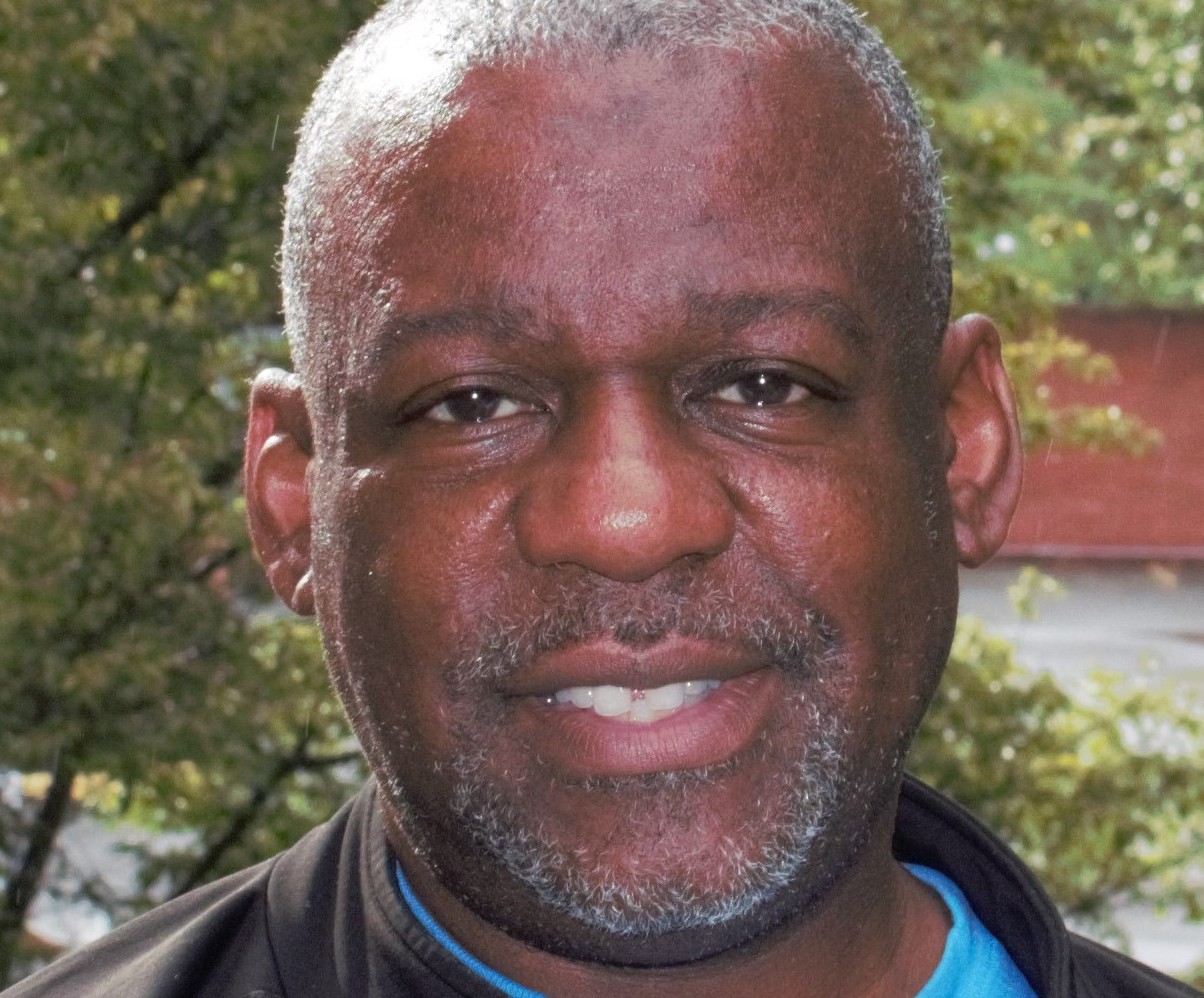
Tyrone Aiken danced prodigiously as a youth, trained at The Ailey School as a young adult, worked as a professional dancer at the height of the New York dance ferment,…
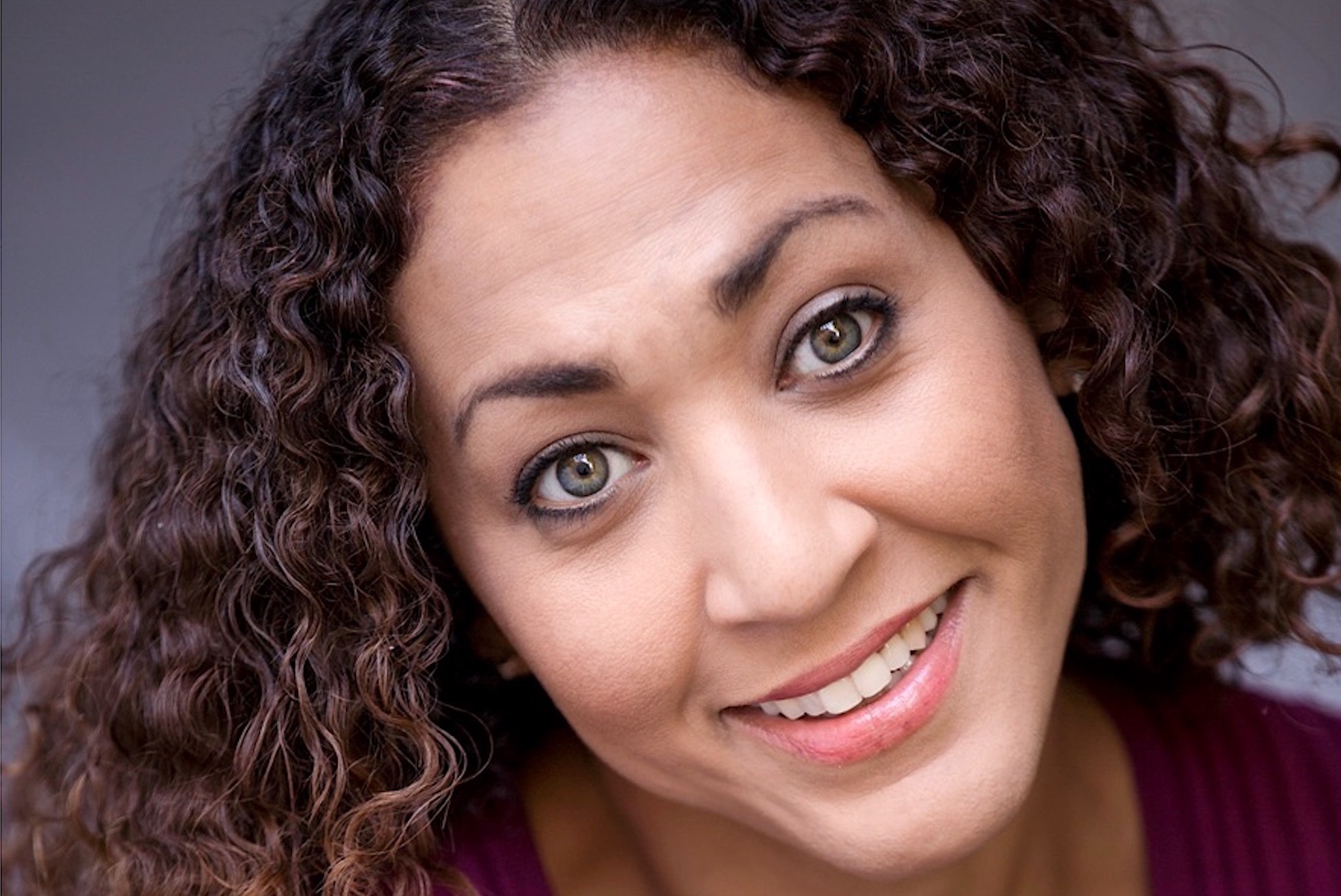
CAROLINE DAHM Dancer, choreographer, producer, master teacher, adjunct dance professor at The UMKC Conservatory, assistant director at Wylliams/Henry Contemporary Dance Company What I love about the Kansas City performing-arts scene: Kansas…
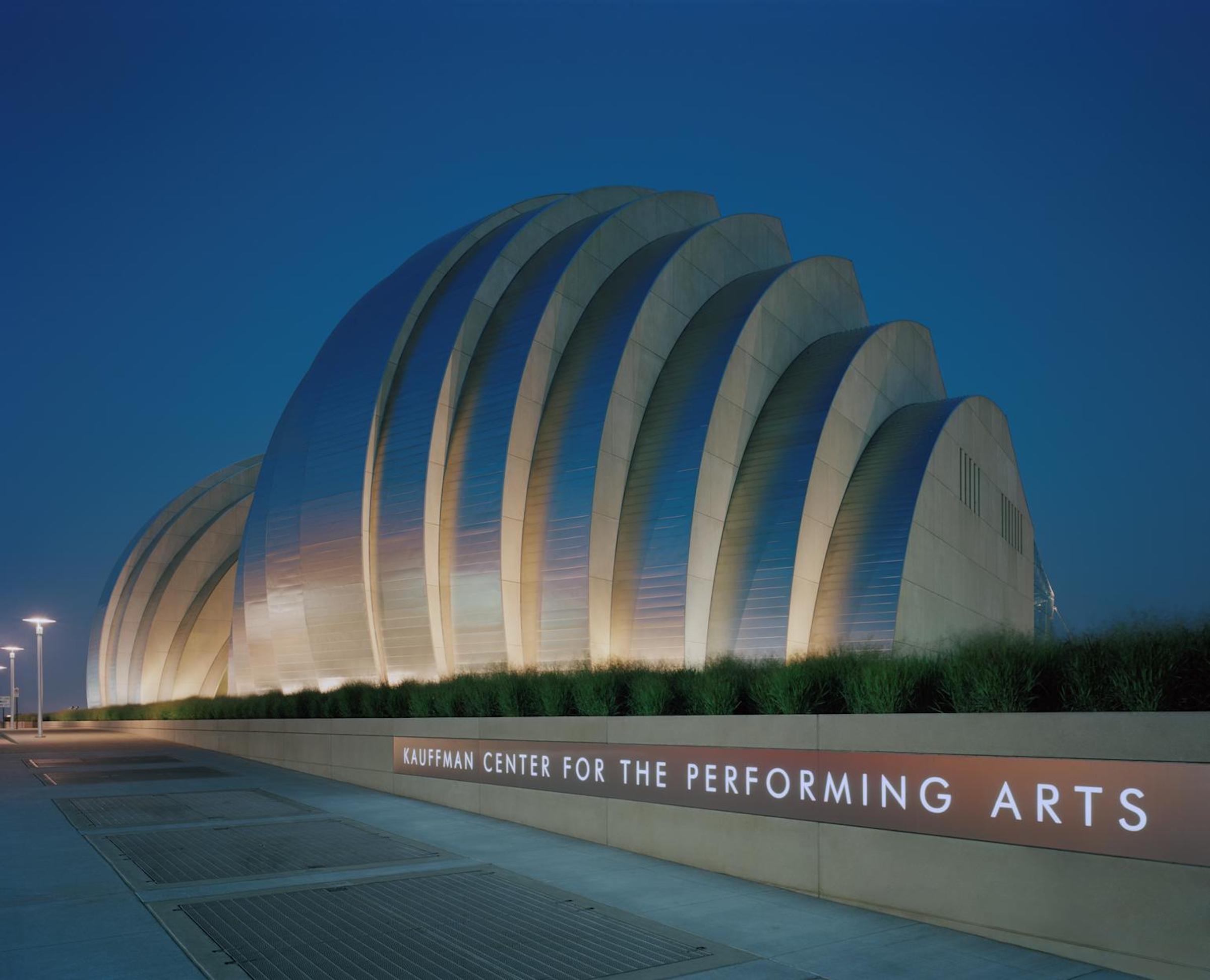
It’s difficult to remember what the Kansas City skyline looked like 20 years ago, before the Kauffman Center for the Performing Arts began to take shape at 16th and Broadway.…


